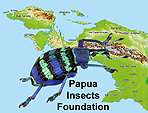

Papua-Insects.nl
The Papua Insects Foundation
The Scoliidae (Hymenoptera) of Papua Indonesia
by Gerard G. M. Schulten
Taxonomical notes on Campsomeris cameroni, C. formosa, C. oresbios, C. microspatulata and C. tasmaniensis
Argaman’s key brings Radumeris radula (Fabricius) and Radumeris tasmaniensis (de Saussure) in the genus Radumeris Betrem.
R. tasmaniensis has the same characteristics as the type species R. radumeris but is without doubt a different species.Mentioned key also places, Campsomeris cameroni Betrem, Campsomeris formosa Guérin and Campsomeris microspatula Tuyn in the genus Radula. A crucial difference between these species and the type species is the incomplete or absent nervus secundus in both sexes.
Campsomeris cameroni Betrem
Argaman’s key runs Radumeris radula (Fabricius) and Radumeris tasmaniensis (de Saussure) to the genus Radumeris Betrem.
Radumeris tasmaniensis has the same characteristics as the type species R. radumeris but is without doubt a different species.
Mentioned key also places, Campsomeris cameroni Betrem, Campsomeris formosa Guérin and Campsomeris microspatula Tuyn in the genus Radumeris. A crucial difference between these species and the type species is the incomplete or absent nervus secundus in both sexes.
Betrem (1928) places C.cameroni (only known from the type species) near Campsomeris annulata Fabricius. This cannot be correct. Tuyn (1963) suggests that this species is near C. ferox (= R. tasmaniensis) but this is unlikely because tasmaniensis has a complete nervus secundus.
Betrem in litt. to Krombein, 1963 suggests it to be a dark form of C. formosa. This seems to be the best option.Campsomeris formosa Guérin
This species differs not only from the type species R. radula by its incomplete nervus secundus but also by the broadly interrupted carina occipitalis and the densely punctuate vertical part of the vertex in the female (Carina complete in Radumeris, vertex with widely dispersed punctures). The suture between Arpm and Arpl is weakly convex (straight in R. radula). Genitalia of R. radumeris and C. formosa are very similar.The following two species belong to a genus different from formosa because of the very slender first abdominal segment in the male.
Campsomeris microspatulata Tuyn
The female is very similar to Campsomeris fomosa but differs in punctuation (in particular vertical part of vertex with few punctures) and vestiture. The presumed male has a very slender first abdominal segment.Campsomeris oresbios Tuyn
The female is similar to C. formosa with a densely punctate vertical part of the vertex like in C. formosa. The male, however, has a very slender first abdominal segment and much different from the male of C. formosa.
The following listing is proposed (see also the checklist)
Radumeris Betrem, 1962
radula (Fabricius, 1775)
7-cincta Fabricius, 1775
sabulosa de Saussure, 1858
intrudens Smith, 1868
maculiceps Cameron, 1906tasmaniensis (de Saussure, 1854)
ferox de Saussure, 1859
siebersi Betrem, 1928
rosenbergi Betrem, 1928Two Undescribed Genera near Radula:
GENUS 1
cameroni (Betrem, 1928)
formosa (Guérin, 1835)
culta Smith, 1861
subopaca Turner, 1909
formosoides Betrem, 1928GENUS 2
microspatulata (Tuyn, 1961)
oresbios (Tuyn, 1961)
ssp. oresbios (Tuyn, 1961)
melanoxantha Tuyn, 1961